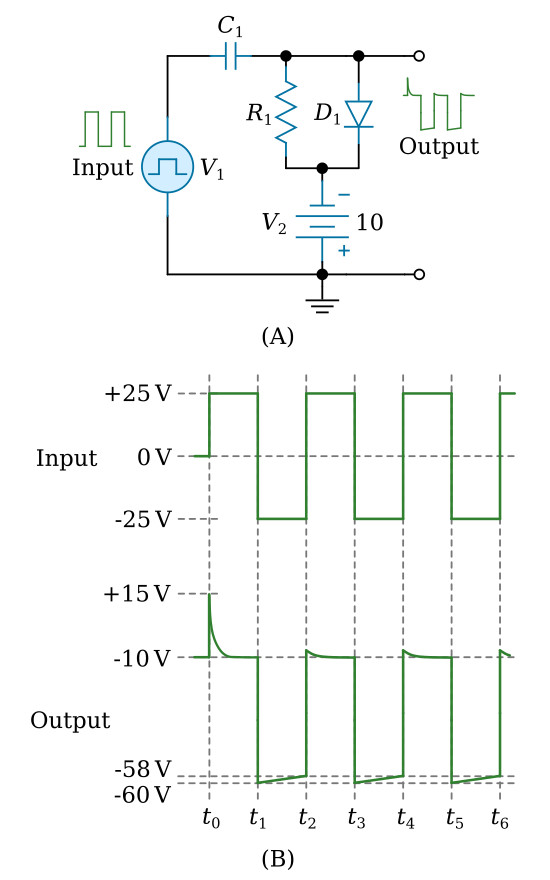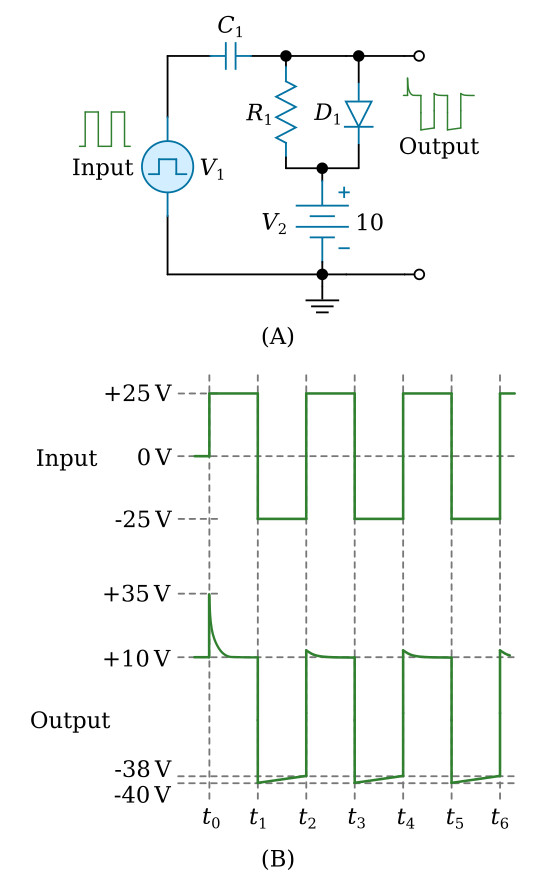Home > Textbooks > Basic Electronics > Wave Shaping > Negative Diode Clampers >
Wave Shaping
Negative Diode Clampers
The figure below, view A, illustrates the circuit of a negative diode clamper. Compare this with the positive-diode clamper shown previously. Note that the diode is reversed with reference to ground. Like the positive clamper, resistor R1 provides a discharge path for C1; the resistance must be a large value for C1 to have a long discharge time. The low resistance of the diode provides a fast charge path for C1. Once C1 becomes charged, it acts as a source of voltage which will help determine the maximum and minimum voltage levels of the output wave shape. The input wave shape shown in view B is a square wave which varies between +25 and -25 volts. The output wave shapes are shown in the bottom half of view B. You will find that the operation of the negative clamper is similar to that of the positive clamper, except for the reversal of polarities.

At t0 the +25 volt input signal applied to the circuit appears across R1 and D1. This makes the anode of D1 positive with respect to the cathode and it conducts heavily. Diode resistance is very small causing C1 to charge quickly. As the voltage across C1 increases, the output voltage decreases. The voltage across C1 reaches 25 volts quickly; during most of t0 to t1, the output voltage is 0.
At t1 the voltage across the capacitor and the input voltage are series aiding and result in -50 volts appearing at the output. At this time the diode is reverse biased and does not conduct. Because of the value of R1 and C1, the capacitor discharges only 2 volts to approximately 23 volts from t1 to t2. Using Kirchhoff's voltage law to determine voltage in the circuit, we find that the output voltage decreases from -50 to -48 volts.
At t2 the +25 volt input signal and the 23 volts across C1 are series opposing. The output voltage is +2 volts. The anode of D1 is positive with respect to the cathode and D1 will conduct. From t2 to t3, C1 charges quickly from 23 to 25 volts through D1. At the same time, the output voltage falls from +2 to 0 volts.
At t3 the input and capacitor voltages are series aiding and the total output voltage is -50 volts. From t3 to t4, D1 is reverse biased and C1 discharges through R1. The circuit operation is now the same as it was from t1 to t2. The circuit operation for the following square-wave cycles duplicates the operation which occurred from t1 to t3.
As was the case with the positive clamper, the amplitude and wave shape of the output is almost identical to that of the input. However, note that the upper extremity of the output wave shape is clamped to 0 volts; that is, the output wave shape, for all practical purposes, lies entirely below the 0-volt reference level.
Negative Diode Clamper With Negative Bias
View A of the figure below is the circuit of a negative clamper with negative bias. Again, with no input signal the capacitor charges to the battery voltage and the output is negative because the positive side of the battery is ground. The bottom of view B shows the output of the circuit. Study the figure carefully, and note the following important points. The peak-to-peak amplitude and shape of the output wave, for all practical purposes, are the same as that of the input wave. The output wave is clamped to -10 volts which is the value of the battery. Since this is a negative clamper, the upper extremity of the waveform touches the -10 volt reference line (and the rest of it lies below this voltage level).

Let's review the important points of circuit operation. The capacitor is initially charged to -10 volts with no input signal. Applying Kirchhoff's law we find that the +25 volt input signal and the 10-volt battery are in series. This series connection forward biases D1 and the capacitor charges to -35 volts. The output voltage is equal to the sum of the capacitor voltage and the input voltage. Thus, the output voltage is -10 volts and the wave shape is clamped to -10 volts. With a -25 volt input, the charge maintained across C1 and the input are series aiding and provide a -60 volt output. C1 will discharge just before the next cycle begins and the input becomes positive. The +25 volt input signal and the approximately -33 volt charge remaining on C1 will forward bias D1 and the output will be clamped to the battery voltage. C1 will quickly charge to the input signal level plus battery voltage. Thus, the output voltage varies between -10 and -60 volts and the wave shape is clamped to -10 volts.
Negative Clamper With Positive Bias
View A of the figure below illustrates the circuit of a negative clamper with positive bias. With no input signal the capacitor charges to the battery voltage and the output is positive because the negative side of the battery is grounded. The output is illustrated in the bottom half of view B. Study the figure carefully and note the following important points. The peak-to-peak amplitude and shape of the output waveform, for all practical purposes, are the same as that of the input. The output wave is clamped to +10 volts, the value of the battery. Since this is a negative clamper (cathode to ground), the top of the output wave touches the +10 volt reference line.

Let's go over a summary of the circuit operation. With no input signal the capacitor charges to 10 volts. The +25 volt input signal forward biases D1. With the 10-volt battery and the input in series, the capacitor charges to -15 volts. The capacitor remains charged, for all practical purposes, since its discharge through R1 (very large) is almost negligible. The output voltage is equal to the algebraic sum of the capacitor voltage and the input voltage. The +25 volt input signal added to the -15 volt capacitor charge provides a +10 volt output. With a -25 volt input at t1, D1 is reverse-biased and the charge across C1 adds to the input voltage to provide a -40 volt output. From t1 to t2, the capacitor loses only a small portion of its charge. At t2 the input signal is +25 volts and the output returns to +10 volts. The wave shape is negatively clamped to +10 volts by the battery.
We can say, then, that positive clamping sets the wave shape above (negative peak on) the reference level, and negative clamping places the wave shape below (positive peak on) the reference level.






